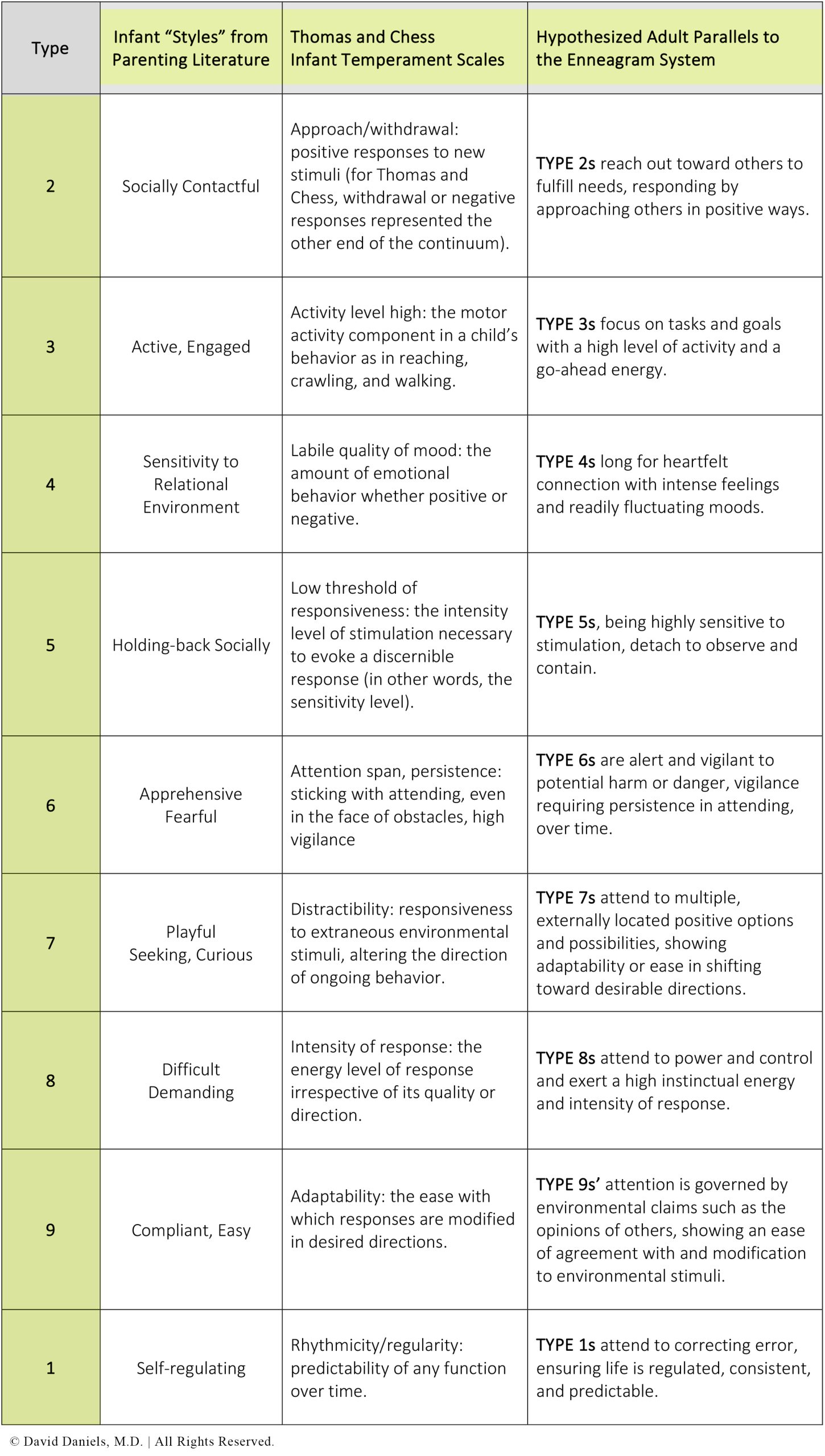How Our Somatic Reactions Tell Us Much About How We Are Wired…
 Have you noticed that in addition to each of us manifesting a particular personality pattern (easily recognized once you study the Enneagram system, I might add), that we also manifest identifiable “physical,” somatic patterning as well, patterns that stay with us across a lifetime?
Have you noticed that in addition to each of us manifesting a particular personality pattern (easily recognized once you study the Enneagram system, I might add), that we also manifest identifiable “physical,” somatic patterning as well, patterns that stay with us across a lifetime?
For example, we can see that one person may be quiet, more withdrawn per se, taking time to respond to situations while another person may be notably loud, quick to respond, and confrontative even? Some of us are more naturally outgoing, “extroverted,” whereas others can be more reserved, “introverted.” Some of us are quickly irritated, whereas others rarely get upset; some respond aggressively, whereas others respond more gently or not at all.
Did we “choose” how we responded to situations when we were little, on up? Or, did “something inside of us,” something about the way we are each wired, choose the response seemingly automatically, for us?
Mothers often say that they experienced their young children differently, even when carrying the child in utero.
Why is this?
Temperament
It’s time to talk about temperament, meaning, a person’s innate nature, especially as it ultimately determines much of our automatic, habitual behavior. It’s what’s activated in order to deal with and respond to our environmental experience. Speaking personally, I know that I have virtually wrestled with the same somatic pattern(s) across my life span. That said, my work of personal development has changed the way I manifest and manage these patterns; I am now less owned by them. I have built up capacities to respond differently to situations, yet that original pattern is still there and shows up readily as a first response.
For example, as a Type 6, I now know that I easily magnify potentially dangerous situations and anything I believe I might not be able count on, but I have learned to identify these tendencies and work with them. I can pause now and ask myself how I’m amplifying or catastrophizing a given situation. Learning to tune into this gives me the chance to keep my anxiety under control as well as frees me from the habitual constraints of my innate reactionary pattern(s) — of magnifying and generating heaps of anxiety.
In fact, Alexander Thomas and Stella Chess in their longitudinal study conducted in the 1970s (see Thomas and Chess: Temperament and Development, New York, Brunner/Mazel, 1977) found nine, yes nine, known temperament styles in very young children three to 18 months of age. Children younger than three months were not included in their study as the time and expense to examine even younger infants was too intensive. Over time, the ongoing development of all nine patterns (types) were equally recognized.
Here below are the nine temperaments as described by Thomas and Chess. Important to note: In their longitudinal study, no temperament was any more or less emotionally healthy than any other one.

These are remarkable findings, as they identify that there’s more to us than how we are nurtured as to what organizes who we are and who we become. Also remarkable to me, is that these nine identifiable temperaments align very succinctly with the nine Enneagram patterns as we know them, and each path of development. As I mentioned earlier, many mothers of more than one child report vast differences in each of their infant’s personalities, including their energetic activities and movements — even noted while in utero. While there are many possible variables that might be attributed to these differences, innate temperament, as it’s forming in utero, may very well be a contributing factor.
Temperament, as we might understand it, is a “way we are biologically organized” and is deeply rooted in our soma, in our body’s fundamental response system. Working with our temperament in order to modify our response system requires time and self-awareness, but doing so can lead to greater “response flexibility.” This is an outcome very much worth pursuing as part of our personal development. Yet, keep this in mind, it’s not about changing our temperament for another temperament, as that’s extremely difficult if not impossible. It’s about understanding our own core temperament, accepting it, seeing the benefits of it, and then opening ourselves up to expansion and practice.
For example, a Type 3 child with a high level of activity is often considered hyperactive as only rarely does he slow down to reflect or notice his feelings in the midst of doing, performing, and accomplishing; this is fundamental to his temperament. He (or she) just wants to go for it, do things, stay active and occupied and on-task.
Where as the Type 4 child’s corresponding temperament is called “labile quality of mood,” meaning, swinging from positive feelings (like joy and euphoria) to negative feelings, like sadness or unwantedness, which reinforces a sensitivity to believing that one is deficient or lacking. This child’s developmental path is to learn that feelings are not necessarily valid in that they need to become aware of how a negative core belief can impact and even derail their feelings as much as something coning at them from the outside; feelings are driven and guided by connection and love (for self and for other) and by the challenges may we face at any given time, and are best not driven by an innate sense of deficiency.
Lastly, a Type 8 child easily expresses a lot of intensity, is high energy and is readily responsive; it’s a child that does not want to be stopped from doing what he or she wants, at any given time. This child’s developmental path is to expand their energetic impulses to include a softening and a slowing of the response system, noticing how they can over impact others. Type 8s otherwise can suffer greatly as children from being punished or admonished for their exuberance, willfulness and explosiveness, which they can internalize as unfair and hurtful and come to believe they are fundamentally destructive in one way or another.
When we are able to recognize a child’s innate temperament, a whole lot of information about that child is now available to us, giving us much more to work with as parents, siblings, teachers, and caregivers. For example, the Type 3 child can be encouraged to complement doing, performing, and accomplishing with slowing down (as is appropriate), feeling their feelings as well as expressing their feelings, and just being present to the value of themselves “when idle.” The Type 4 child can be held, comforted, and reminded that there is much truth to be experienced about themselves that reaches beyond their immediate and fluctuating feelings, and that they are “okay” despite the rush of feeling badly about themselves or their surroundings. The Type 8 child can be guided to learn additional ways to express energy and interact with others, including learning to soften their touch, simply be present and more receptive to others, and feel into their own gentleness and kindness. These are simply examples, but they are important to consider.
Making a Difference in a Child’s Development
When parents and thus caregivers know about temperament styles — understanding our innate, core differences, it prevents us from wondering why a child might be so different from us; it prevents us from shaming a child — or at worst, for punishing a child — for those differences. We are furthermore able to more successfully attune to each child uniquely, thus, enabling them to attune properly and successfully to themselves. Most importantly, understanding and respecting temperament styles as different, one from another, allows each of us to love each child in ways that furthers the child’s development, self-acceptance, and ultimately, their own capacity for personal happiness.
For example, knowing the Type 4 child’s temperament helps us to understand that this child is very sensitive to how they are being cared about, felt and understood, knowing the Type 3 child’s corresponding temperament allows us to understand how easily this child can get focused on accomplishment and performance and can overlook their own feelings or authenticity, and knowing the Type 8 child’s corresponding temperament allows us to understand the exuberance and at times over abundance of energy, which helps us give that child the space and autonomy as well as guidance they might need for their development.
Non-acceptance of a child’s innate temperament can be confounding for a child and can lead to rebellion and defiance, self-rejection, self-confusion all the way to self-hate. How we accept and love a child leads directly to how they come to accept and love themselves. Respecting a child’s innate temperament — corresponding Enneagram type — allows us to best guide the child’s temperament (the foundation of their forming personality) for optimal growth and development.
Reflection, Impacting How We Parent
In reading this blog, do take some time to reflect on your own temperament — corresponding Enneagram type — and the temperament (type) of others in your life. Review how this understanding can make a difference in how you react and behave, toward yourself and toward others. Be sure to grasp how this understanding, based on your own type, can make a great difference in your openness to growth— response flexibility — and ultimately, constructive change.
When we as parents and caregivers in general acknowledge and recognize the nine innate temperaments — nine core personality types – we can ideally adjust our parenting style specifically to each child we interact with.
The Importance of the Enneagram
In my opinion, this is the kind of knowledge that makes the Enneagram the gift that it truly is. To have a tool at our disposal that can so greatly impact our interactions (with not only our selves and each other but with our developing children) is the greatest of gifts I can think of.
Adaptive Parenting
We need and it’s my recommendation that we adapt our parenting to fit the child’s temperament pattern, not the other way around, which can look more like forcing a child to be like us or some model we’ve come to believe they should be.
We need to bring the Enneagram systems to parents and caregivers, teachers and group leaders in order to ensure that each child in our society has the best chance possible at developing a healthy personality — a healthy sense of self and a healthy sense of others; the proper development of each child is critical to the success and well-being of our species. Thus, the Enneagram can be correctly viewed as a vital contributor to parenting and healthy infant and child development.
Take a moment to reflect upon this.
Your Thoughts and Experience
- Did your parents adapt to the different personality styles of each child in your family?
- Did you feel they treated you fairly, given your temperament’s — Enneagram type’s — pattern?
- What about your experience as a parent? Have you recognized and have been able to adapt to the different temperaments in each of your children?
On behalf of David Daniels, M.D., feel free to respond to this blog, sharing your thoughts and feelings with others. As ever, with gratitude for your contribution.
Suzanne Dion for David Daniels

